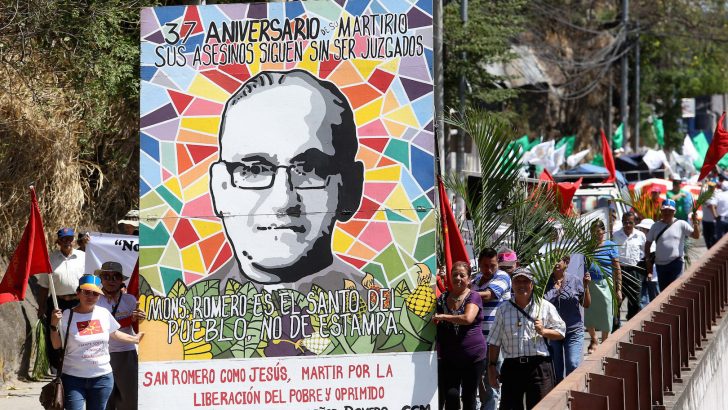Carlos X. Colorado
Romero’s centennial coincides with the 100th anniversary of the Marian apparitions at Fatima, and it is useful to take Fatima as a guidepost to situate Romero’s life in the life of the Church. Indeed, the major thematic set points in the Fatima message – the World’s wars and the Church’s sufferings in these conflicts – would define Romero’s life.
Blessed Oscar Romero, the martyred Salvadoran archbishop beatified by Pope Francis in 2015, was born 100 years ago this week, on August 15, 1917, and his centennial was marked by devotees around the world.
At a memorial service at St. George’s Cathedral in London on Saturday, August 12, Archbishop Vincenzo Paglia, postulator of Romero’s canonisation cause, reminded over 500 attendees gathered there that they joined faithful “in El Salvador and in other parts of the world, to remember this shepherd for his Gospel witness that brings light to believers and non-believers alike.”
He added that, “my great hope is that Pope Francis will soon canonise him a saint”.
Paglia told Vatican Radio that canonisation may come as soon as next year.
In Romero’s El Salvador, 1,500 pilgrims walked from his tomb in the San Salvador Cathedral to the highland village where Romero was born 100 years ago, some 90 miles away. Pope Francis sent Chilean Cardinal Ricardo Ezzati as his personal representative to the commemorations, publishing the letter of his commission, in which the Pope calls Romero an “illustrious pastor and witness of the Gospel”.
Human dignity
The Pontiff writes that Romero was a “defender of the Church and of human dignity”, and a herald of “the saving work” of Christ, manifested in his “love for all, especially the poor, the abandoned and the marginalised”, seeking to promote “reconciliation and peace”.
In the United States, Los Angeles Archbishop Jose Gomez celebrated a commemorative Mass for Romero at Our Lady of Angels Cathedral, while Dallas Bishop Edward Burns is presiding at a Mass at the Cathedral Shrine of the Virgin of Guadalupe, calling on all his priests to celebrate similar masses in their parishes. An independent group of Romero devotees that promoted the Romero centennial in the United States documented commemorations in various Latin American countries and in places as far-flung as Kuala Lumpur, Malaysia.
Romero’s centennial coincides with the 100th anniversary of the Marian apparitions at Fatima, and it is useful to take Fatima as a guidepost to situate Romero’s life in the life of the Church. Indeed, the major thematic set points in the Fatima message – the World’s wars and the Church’s sufferings in these conflicts – would define Romero’s life.
He spent six years in Rome during WWII, and he attributed the resolve of the pontiffs of the 30s and 40s – especially, Pius XI – as informing his ideal of the Church’s stance before dictators and strongmen. Of course, Romero also lived and intimately bore the pains of the Cold War, in which El Salvador was a flashpoint and in which his own immolation played a part.
The Church was recognisable but different in 1917, when Romero was born. Neither St John Paul II (born 1920), Pope Emeritus Benedict XVI (b. 1927) nor Pope Francis (b. 1936), were yet in the world. Romero’s life mirrors the trajectory of the Church in the 20th Century, especially with respect to the Second Vatican Council, through which the Church committed itself to pursuing justice in the world. Romero embodies both the ‘pre-conciliar’ mindset and the ‘post-conciliar’ spirit that ensued.
The earlier, conservative Romero, who never appeared without a cassock, is a sort of pre-conciliar archetype; while the later, prophetic Romero who rails against human rights abuses and socioeconomic injustice is the idealised, heroic ‘Vatican II bishop’.
Many of the debates about the Council – for example, whether it constituted a rupture or an evolution – can be applied to Romero himself, who is seen by some as bucking the system, while others view him as faithfully evolving with the Church’s refreshed outlook in a ‘hermeneutic of continuity’.
Foundations
These profound foundations for Romero’s relevance are bolstered by something much closer to the surface in his story – he was killed at the altar as he was about to consecrate the Eucharist. He was a bishop reduced to scorn and persecution in a Catholic country. There is an iconic, Hollywood quality to his assassination which, taken together with his commitment to the poor, his similarities with Pope Francis, and his textbook fulfilment of a modern martyrdom, makes Oscar Romero a most accessible saint and point of reference for our era.
“One hundred years after his birth,” Gomez said at the tribute at the L.A. Cathedral, “Blessed Oscar Romero still inspires us for his humility and courage – for his love for the poor and his witness of solidarity and service to others, even to the point of laying down his life.”
Carlos X. Colorado is a Salvadoran-American attorney who lives and works in Los Angeles. His blog, Super Martyrio at polycarpi.blogspot.com, follows Romero’s canonisation cause.


 Photos of Blessed Oscar Romero are carried during a march to celebrate his life.
Photos of Blessed Oscar Romero are carried during a march to celebrate his life. 